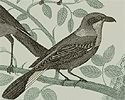The Language of Birds
(ready-made)
PROLOGUE
|
Once, a mechanic nightingale, made the Emperor of Chinaís hours happy. His little body, covered with gold and diamond plates, kept within it a delicate clock mechanism that enabled it to perform, once and again, the most beautiful music.
Birds had traditionally been symbols of feelings or human properties. Many stories even tell us about the faculty of speech that certain birds have. This faculty is, however, hidden to man. Few ones could, nevertheless, share that secret. Among them: Anaximander, Apollonius of Triana (curiously they were both magicians) and Aesopus himself.
Itís also famous the mystical poem " The colloquy of Birds" written by Farid Uddin Attar on the XII century A: C, in which all the birds of the world get together to find their king, the Simurg (described by different sources as a bird with metallic orange feathers, that has four wings, a peacock tail and a human head) that had dropped one of its splendid feathers in the middle of (curiously too) China.
Birds that tell great truths use to appear, since ancient times, in numerous fables in the West as well as in the East. Mythology tells us that Tiresias, the fortuneteller, also knew perfectly well the language of the birds (the goddess of wisdom, Minerva had taught it to him). Saint Frances of Asis dedicated his preaching to the birds, because his words were more appreciated by them that by men, obstinate to live in ignorance.
The birds from " The language of Birds", however, as the Emperor of Chinaís nightingale are more similar to the courtís Teacher of Music favorite automaton than to these enlightened birds. " This one was really educated in my school" bragged Hans Christian Andersenís teacher. He was so proud about his metallic nightingale, which was able to repeat until boredom the same scales and rhythms, the same valses and sonatas that he dedicated to write, with complicated Chinese characters, twenty-four long and erudite volumes about the mechanic bird.
The birds from " The Language of Birds" are poet-machines. In this sense they share with the Emperorís mechanic bird, in the first place, the paradox of combining an extreme fragility with a rigid monstrous armor. They also share the fact that they are programmed to re-quote words. But, are the words not always anotherís?
Italo Calvino said that all writers at the end are machines; they work putting one word after the other following predefined rules, codes and adequate instructions. In fact, literature cannot stop being implicit in language rules. Or, in the best of cases, moved from the call of the unutterable, continues its tragic struggle to free itself from its boundaries without achieving it.
Besides the birds of " The language of birds" there are other birds, even more aberrant: those that are made only by words. Swans, sea gulls, crows and nightingales are presented to us as linguistic birds, captured by the poet-machines inside an inviolable signifying armor.
This is the tragic song of the birds of " The language of birds", as more as they sing as more as the cage of language hopelessly traps them.
BELEN GACHE
